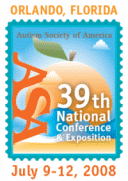 |
The ASA's 39th National Conference on Autism Spectrum Disorders of ASAThe Westin Kierland Resort & Spa, Scottsdale, AZ |
| For a complete author index with session numbers, please click here | |
| Thursday, July 10, 2008: 12:30 PM-1:45 PM | |||
| Tampa 2 | |||
| #3259- Autism: Language Strategies for Learning with A Visual Brain | |||
| The presenters will explain how learning with a “visual brain” affects a person with ASD’s ability to learn to behave, to be socially appropriate, to be able to learn specific academic skills, and/or learn to talk. Developmental changes will be demonstrated though the use of writing, drawing, speaking, and reading related to academics, social and behavioral issues. The presenters will also show how to implement the various strategies based on the strength of the learner for acquiring concepts and language. | |||
| Presenters: | - Carole Kaulitz has been in the field of education for 36 years and is currently self-employed as a speech-language pathologist, autism consultant, and deaf/hard-of-hearing specialist, in Vancouver, WA. Carole has extensive training in multi-methodologies related to both autism and deafness, and has presented numerous workshops nationwide.
- Dr. Ellyn Lucas Arwood has 37 years of clinical language experience with various special needs populations in a variety of settings, including universities, hospitals, alternative and regular school settings, and clinics. She is the author of five textbooks and provides training, education, and consultation to numerous organizations and agencies. | ||
|
| |||
| This workshop will describe how individuals impacted by autism spectrum disorders (ASD) use the neurobiological learning system for developing communication, behavior, and academics, first as perceptual learning and then as part of how language functions. Individuals with autism spectrum disorders (ASD) rely on perceptual processing for learning, and the one learning characteristic that they have in common is a visual meta-linguistic way of thinking. The presenters will explain how learning with a “visual brain” affects a person with ASD's ability to learn to behave, to be socially appropriate, to be able to learn specific academic skills, and/or learn to talk. Since visual concepts develop through very specific types of perceptual patterns, the presenters will take the participants through the way the patterns form concepts that develop language. Then the presenters will show a videotape of a youth severely impacted by autism learning to comply, communicate, and socialize by utilizing the theory of the visual brain-based language strategies. The videotape will show the youth's baseline of behavior as well as the stages of change over a six week period and the presenters will describe the theory and rationale for the effective practices viewed on the tape. In addition to the videotaped youth, the presenters will provide numerous case studies of other children at various levels and ages who learn social, behavioral, and academic skills through visual language-based strategies. Developmental changes will be demonstrated though the use of writing, drawing, speaking, and reading samples related to academics, social and behavioral issues. It should be noted that the presenters are not referring to learning styles which are educated preferences but are referring to the learning system as based on neuroscience. Furthermore, the presenters will show how to implement the various strategies based on the strength of the learner for acquiring concepts and language. | |||
See more of General Submissions
See more of The ASA's 39th National Conference on Autism Spectrum Disorders